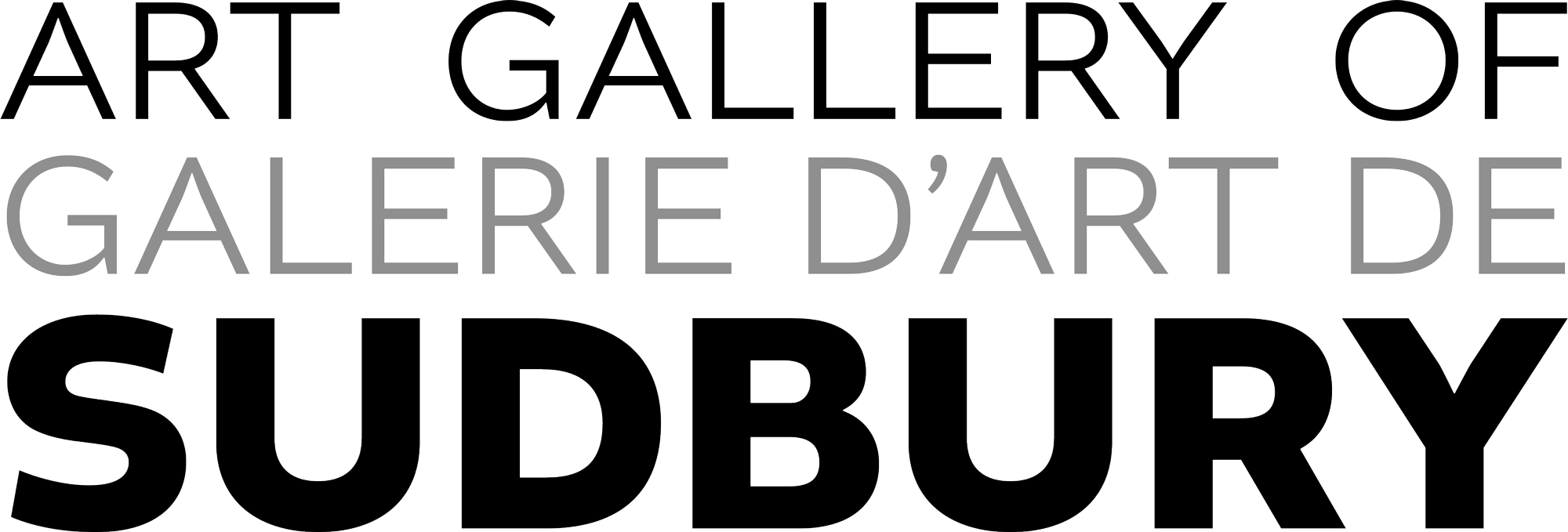Creating in Kinngait
ᓴᖅᑭᑎᕆᓂᖅ ᑭᙵᕐᓂ
Establishing the Inuit drawing tradition
ᐋᖅᑭᒃᓱᐃᓂᖅ ᐃᓄᐃᑦ ᑎᑎᕋᐅᔭᕐᓂᖏᑕ ᐱᖅᑯᓯᖓᓂ
Following the decline of the fur trade, the Canadian Department of Indian Affairs and Northern Development stationed James Houston in the Inuk territory of Kinngait. Houston was charged with the task of setting up an arts and crafts developments in the north.
ᐊᒥᕐᓂᒃ ᓂᐅᕕᐊᒃᓴᖃᕐᓂᖅ ᑲᑕᒃᑎᓪᓗᒍ, ᔭᐃᒻᔅ ᕼᐃᐅᔅᑕᓐ ᓴᓇᕝᕕᒃᑖᖅᑎᑕᐅᓚᐅᖅᑐᖅ ᐃᓄᐃᑦ ᓄᓇᖁᑎᖓᓂ ᑭᙵᐃᑦᒥ ᑎᓕᔭᐅᓪᓗᓂ ᑲᓇᑕᒥ ᓄᓇᖃᖅᑳᖅᑐᓕᕆᔨᒃᑯᑦ ᐊᒻᒪᓗ ᐅᑭᐅᖅᑕᖅᑐᒥ ᐱᕙᓪᓕᐊᑎᑦᑎᓂᔨᒃᑯᓐᓄ. ᕼᐃᐅᔅᑕᓐ ᐱᔭᒃᓴᖅᑖᑎᑕᐅᓚᐅᖅᑐᖅ ᐋᖅᑭᒃᓱᐃᓂᕐᒥ ᑎᑎᕋᐅᔭᕐᓂᕐᒧ ᐊᒻᒪᓗ ᓴᓇᓗᕿᓂᕐᒧ ᐱᕙᓪᓕᐊᑎᑦᑎᓂᕐᒥ ᐅᑭᐅᖅᑕᖅᑐᒥ.
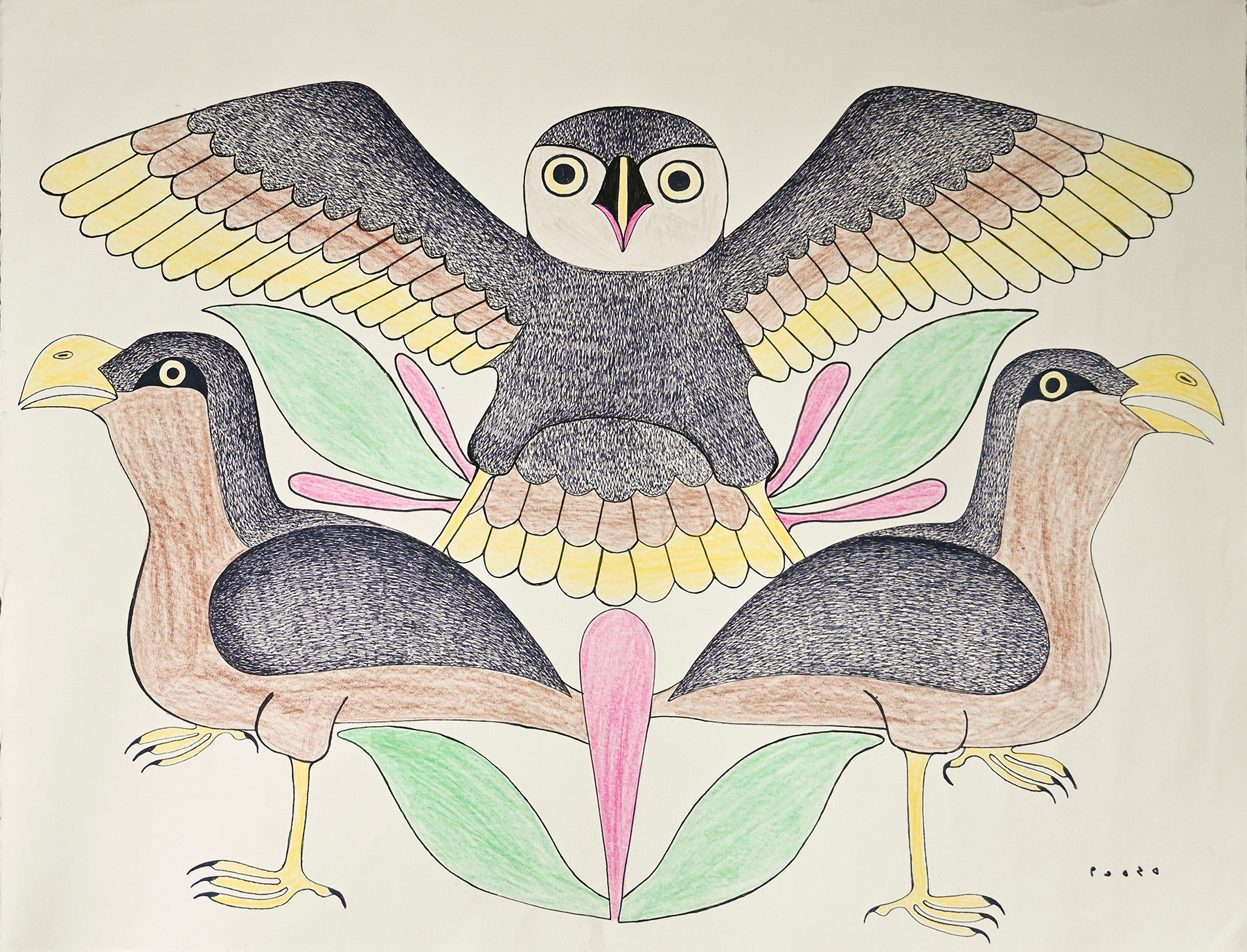
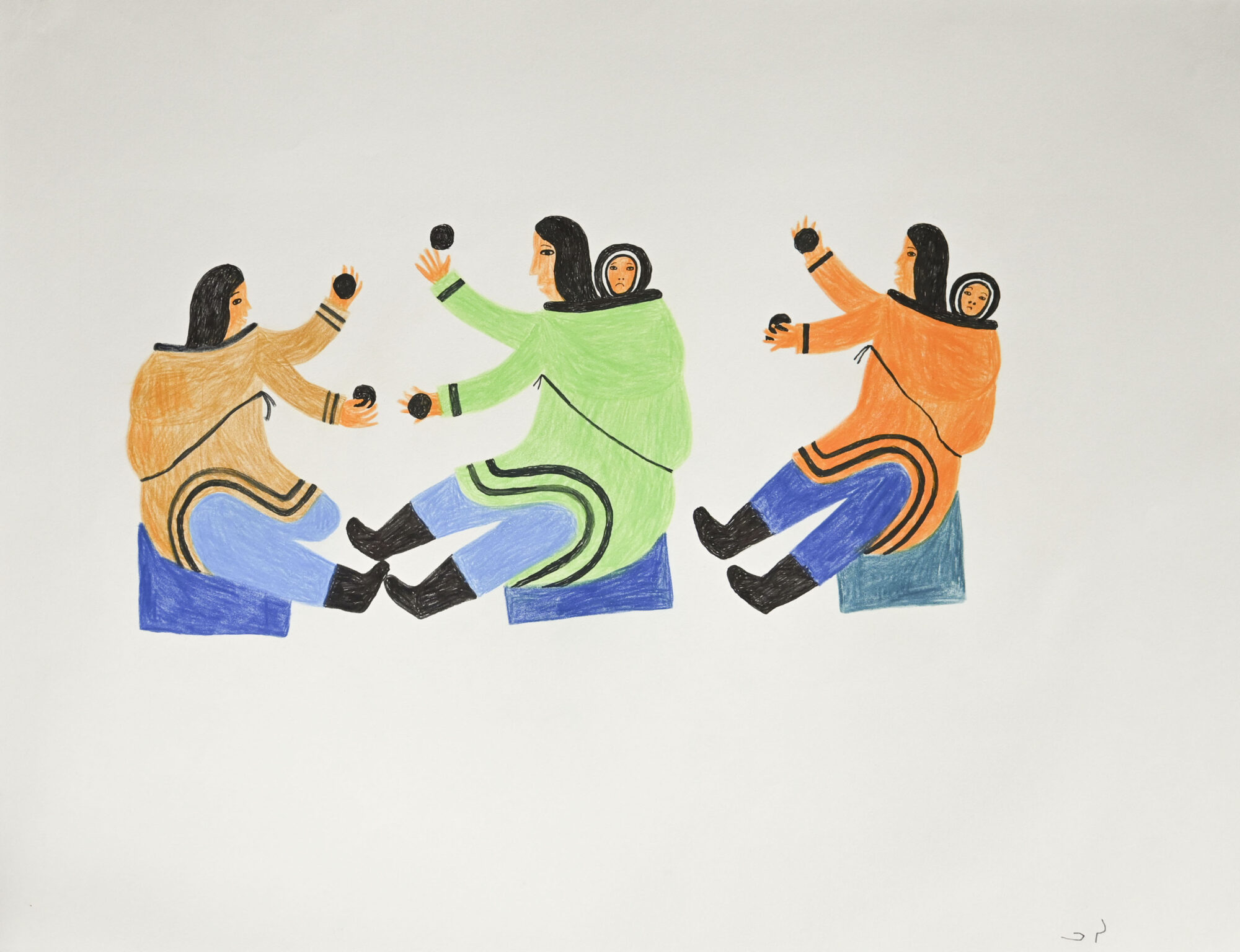
Kenojuak Ashevak, Untitled, undated. Pencil crayon and marker drawing on paper. LUMAC Collection, Art Gallery of Sudbury | Galerie d’art de Sudbury.
ᕿᓐᓄᐊᔪᐊ ᐊᓯᕙᒃ, ᐊᑎᖃᙱᖅᑐᖅ, ᐅᓪᓗᓕᖅᑕᐅᓯᒪᖏᑦᑐᑦ. ᑎᑎᖅᑐᔭᐅᑎᒧᑦ ᐊᒥᐋᖅᑎᕆᔾᔪᑎᒧᑦ ᐊᒻᒪᓗ ᑎᑦᑕᕆᒃᑎᑦᑎᔪᕐᒧᑦ ᑎᑎᖅᑐᒐᖅᓯᒪᔪᖅ ᐊᓕᓚᔪᐊᓄᑦ. ᓗᕋᓐᓯᐊᓐ ᓯᓚᑦᑐᖅᓴᕐᕕᐊᓗᒃᒥᑦ ᑕᑯᔭᒐᖃᕐᕕᒃᒥ ᐊᒻᒪᓗ ᓴᓇᐅᒐᓕᕆᕝᕕᒃᒥ ᓄᐊᓯᒪᔭᖏᑦ, ᓴᓇᖕᖑᐊᖅᓯᒪᔪᓂᒃ ᑕᑯᔭᒐᖃᕐᕕᒃ ᓴᑦᐳᓕ.
Lucy Qinnuayuak, Untilted (Inuit Women Juggling), 1977-78. Pencil, crayon and black marker drawing on paper. LUMAC Collection, Art Gallery of Sudbury | Galerie d’art de Sudbury.
ᓘᓯ ᕿᓐᓄᐊᔪᐊ, ᐊᑎᖃᙱᖅᑐᖅ (ᐃᓄᒃ ᐊᕐᓇᐃᑦ ᐃᒡᓗᑭᓵᖅᑐᑦ), 1977-78. ᑎᑎᖅᑐᔭᐅᑎᒧᑦ ᐊᒥᐋᖅᑎᕆᔾᔪᑎᒧᑦ ᐊᒻᒪᓗ ᕿᕐᓂᖅᑕᖅ ᑎᑦᑕᕆᒃᑎᑦᑎᔪᕐᒧᑦ ᑎᑎᖅᑐᒐᖅᓯᒪᔪᖅ ᐊᓕᓚᔪᐊᓄᑦ. ᓗᕋᓐᓯᐊᓐ ᓯᓚᑦᑐᖅᓴᕐᕕᐊᓗᒃᒥᑦ ᑕᑯᔭᒐᖃᕐᕕᒃᒥ ᐊᒻᒪᓗ ᓴᓇᐅᒐᓕᕆᕝᕕᒃᒥ ᓄᐊᓯᒪᔭᖏᑦ, ᓴᓇᖕᖑᐊᖅᓯᒪᔪᓂᒃ ᑕᑯᔭᒐᖃᕐᕕᒃ ᓴᑦᐳᓕ.
The arts and crafts development was initiated to enterprise the Inuit’s prolific carving and craftsman skills. But given the weight and cost of materials to produce sculptures, Houston sought to bring a more accessible medium to the Inuit people in the form of works of art on paper. These drawings were used as the inspiration and direct blueprints to create the stone carving prints that highlighted the artistry in Kinngait. Inuit stone carving, printmaking, and drawings are synonymous for their artistic merits and cultural insight.
ᑎᑎᕋᐅᔭᕐᓂᕐᒧ ᐊᒻᒪᓗ ᓴᓇᓗᕿᓂᕐᒧ ᐱᕙᓪᓕᐊᑎᑦᑎᓂᖅ ᐱᒋᐊᖅᑎᑕᐅᓚᐅᖅᑐᖅ ᑮᓇᐅᔭᓕᐅᕈᓐᓇᖅᓯᖁᓪᓗᒍ ᐃᓄᐃᑦ ᐱᓯᑎᐅᓂᖏ ᓴᓇᙳᐊᕐᓂᕐᒥ ᐊᒻᒪᓗ ᓴᓇᒃᑲᐅᓂᖏᑕ ᐊᔪᖏᓐᓂᖏ ᒪᓕᒃᖢᒋ. ᑭᓯᐊᓂᓕ ᓱᓇᒃᑯᑖᑦ ᐊᑐᕆᐊᓖᑦ ᓴᓇᙳᐊᒐᓕᐅᕐᓂᕐᒧ ᐅᕿᖏᓐᓂᖏ ᐊᒻᒪᓗ ᐊᑭᖏ ᑕᑯᓪᓗᒋ, ᕼᐃᐅᔅᑕᓐ ᕿᓂᓚᐅᖅᑐᖅ ᐊᑐᐃᓐᓇᐅᓂᖅᓴᒥ ᑕᑯᔭᒃᓴᐅᔪᒥ ᐃᓄᐃᑦ ᐃᓄᖕᓄ ᐊᑐᖅᑕᐅᔪᓐᓇᖅᑐᓂ ᐊᓱᐃᓛᒃ ᐸᐃᑉᐹᑎᒍᓪᓗ ᑎᑎᕋᐅᔭᒃᑲᐅᓂᖏ ᑕᑯᒃᓴᐅᑎᑕᐅᓕᕐᓗᑎᒃ. ᑖᒃᑯᐊ ᑎᑎᕋᐅᔭᒐᐃᑦ ᐊᑐᖅᑕᐅᓚᐅᖅᑐᑦ ᐱᔪᒥᒍᓲᑕᐅᓪᓗᑎᒃ ᐊᒻᒪᓗ ᐊᔾᔨᓕᐅᕐᕕᒃᓴᖓᓂ ᓴᖅᑭᑦᑎᔾᔪᑕᐅᓪᓗᑎᒃ ᐅᔭᖅᑲᓂᒃ ᓴᓇᙳᐊᒐᑎᒍᑦ ᑎᑎᕐᑐᒐᓕᐊᓂᒃ ᑕᑯᑎᑦᑎᓪᓗᑎᒃ ᑭᙵᐃᑦ ᐃᓄᖁᑎᖏᑦ ᐱᓯᑎᐅᓂᖏᓐᓂ. ᐃᓄᐃᑦ ᓴᓇᙳᐊᒐᖅᑕᖏ, ᑎᑎᕐᑐᒐᕐᓂᖅ, ᐊᒻᒪᓗ ᑎᑎᕋᐅᔭᕐᓂᖅ ᐊᔾᔨᒌᒃᑑᔪᖅ ᓴᓇᙳᐊᒃᑲᐅᓂᖓᑕ ᓇᓗᓇᖏᓐᓂᖏᓐᓂ ᐊᒻᒪᓗ ᐃᓕᖅᑯᓯᑐᖃᐅᑉ ᒥᒃᓵᓄᑦ ᓯᓚᑐᓂᖏᓐᓂ.
The workshop system developed by Houston separated the printmaking process into two distinct steps. Drawing could be considered a means to an end in the production of a print. First, an artist would create a drawing that Houston would purchase. Houston would then bring this drawing to the printshop where a stone carver would transfer the image from paper to stone to create a relief. However, not all drawings became prints.
ᑎᑎᕐᑐᒐᕐᕕᒃ ᖃᓄᐃᓕᖓᓂᖓ ᐋᖅᑭᒃᑕᐅᔪᖅ ᕼᐃᐅᔅᑕᓐᒧᑦ ᐊᕕᒃᓯᓚᐅᖅᑐᖅ ᑎᑎᕐᑐᒐᕐᓂᕐᒧ ᐱᓕᕆᔾᔪᓯᒪᑦ ᒪᕐᕈᐃᓕᖓᔪᓂᒃ ᐱᓕᕆᔭᕆᐊᓕᖕᓄ. ᑎᑎᕋᐅᔭᕐᓂᖅ ᐃᓱᒪᒋᔭᐅᔪᓐᓇᖅᑐᖅ ᐃᓱᓕᔾᔪᑕᐅᓗᓂ ᑎᑎᕐᑐᒐᓕᒃ ᓴᖅᑭᑎᕆᓂᕐᒥ. ᓯᕗᓪᓕᖅᐹᖅ, ᕼᐃᐅᔅᑕᓐ ᓂᐅᕕᕋᔭᖅᑐᖅ ᑎᑎᕐᑐᒐᖅᑎᐅᑉ ᑎᑎᕋᐅᔭᖅᑕᖓᓂ. ᕼᐃᐅᔅᑕᓐ ᑎᑎᕋᐅᔭᖅᑕᐅᔪᒥ ᑎᑎᕐᑐᒐᕐᕕᖕᒥᐊᖅᓯᓪᓗᓂ ᐊᓱᐃᓛᒃ ᓴᓇᙳᐊᒐᖅᑎ ᑎᑎᕐᑐᒐᕐᒥ ᓴᓇᙳᐊᒐᒃᓴᒧ ᐃᓕᓯᓗᓂ ᐃᓗᑦᑐᐃᖁᓪᓗᒍ. ᑭᓯᐊᓂ, ᑕᒪᐃᓐᓂ ᑎᑎᕋᐅᔭᖅᑕᐅᔪᑦ ᑎᑎᕐᑐᒐᙳᓚᐅᖏᑦᑐᑦ.

Lucy Qinnuayuak, Untitled, 1979. Acrylic paint, marker, pencil and crayon drawing on paper. LUMAC Collection, Art Gallery of Sudbury | Galerie d’art de Sudbury.
ᓘᓯ ᕿᓐᓄᐊᔪᐊ, ᐊᑎᖃᙱᖅᑐᖅ, 1979. ᐊᒥᐋᕆᔾᔪᑎ ᐊᒥᐊᖅ, ᑎᑦᑕᕆᒃᑎᑦᑎᔪᖅ, ᑎᑎᖅᑐᔭᐅᑎ ᐊᒻᒪᓗ ᐊᒥᐋᖅᓯᔾᔪᑎ ᐊᓕᓚᔪᐊᓄᑦ. ᓗᕋᓐᓯᐊᓐ ᓯᓚᑦᑐᖅᓴᕐᕕᐊᓗᒃᒥᑦ ᑕᑯᔭᒐᖃᕐᕕᒃᒥ ᐊᒻᒪᓗ ᓴᓇᐅᒐᓕᕆᕝᕕᒃᒥ ᓄᐊᓯᒪᔭᖏᑦ, ᓴᓇᖕᖑᐊᖅᓯᒪᔪᓂᒃ ᑕᑯᔭᒐᖃᕐᕕᒃ ᓴᑦᐳᓕ.
As Jean Blodgett remarked during her work with the collection of Inuit prints and drawings at the McMichael Canadian Art Collection in the 1990s, drawing became very popular in Kinngait as it was an accessible activity that was much faster and simpler to execute than a traditional stone carving or needlecraft.1 Drawing also appealed to a wider range of individuals as it did not require the same virile strength that stone carving demanded. Able to work from home and at their own convenience, young and old, men and women took up drawing.
ᔩᓐ ᐸᓛᑦᔭᑦ ᐅᖃᓚᐅᖅᑐᖅ ᓴᓇᑎᓪᓗᒋ ᐃᓄᐃᑦ ᑎᑎᕐᑐᒐᖏᓐᓂᒃ ᐊᒻᒪᓗ ᑎᑎᕋᐅᔭᓂᒃ ᓄᐊᑦᑎᓂᕐᒥ ᒥᒃᒪᐃᑯ ᑲᓇᑕᒥ ᓴᓇᙳᐊᕐᓂᕐᒥ ᓄᐊᑦᑎᓂᕐᒥ 1990−ᓂᒃ, ᑎᑎᕋᐅᔭᕐᓂᖅ ᑭᙵᕐᓂᒃ ᐊᑐᖅᑕᐅᒻᒪᕆᓚᐅᖅᑐᖅ ᐱᓕᕆᐊᒃᓴᐅᔪᖅ ᐊᑐᐃᓐᓇᐅᓂᖓᓂ ᓱᒃᑲᓂᖅᓴᐅᔪᒥ ᐊᒻᒪᓗ ᐊᔪᕐᓇᖏᓐᓂᖅᓴᒥ ᐱᓕᕆᔭᕆᐊᒃᓴᖅ ᓴᓇᙳᐊᒐᕐᓂᐅᑉ ᐅᕝᕙᓘᓐᓃᑦ ᒥᖅᓴᕐᓂᐅᑉ ᓴᓂᐊᓂ ᑕᑯᓪᓗᒍ.1 ᑎᑎᕋᐅᔭᕐᓂᖅ ᐃᓄᖕᓄ ᐊᔾᔨᒌᖏᑦᑐᓄ ᐱᔪᒥᒋᔭᐅᓚᐅᖅᑐᖅ ᓴᓇᙳᐊᕐᓂᕐᒧ ᐊᒃᓱᕈᕐᓂᕆᔭᖓᓂ ᐊᔾᔨᖃᖏᓐᓂᖓ ᐱᔾᔪᑎᒋᓪᓗᒍ. ᐊᖏᕐᕋᒥ ᓴᓇᔪᓐᓇᕐᓗᓂ ᐊᒻᒪᓗ ᖃᖓᑐᐃᓐᓇᖅ ᓈᒻᒪᒋᔭᖓᓂ, ᒪᒃᑯᒃᑐᑦ ᐊᒻᒪᓗ ᐃᓄᑐᖃᐃᑦ, ᐊᖑᑏᑦ ᐊᒻᒪᓗ ᐊᕐᓇᐃᑦ ᑎᑎᕋᐅᔭᖃᑦᑕᓕᓚᐅᖅᑐᑦ.
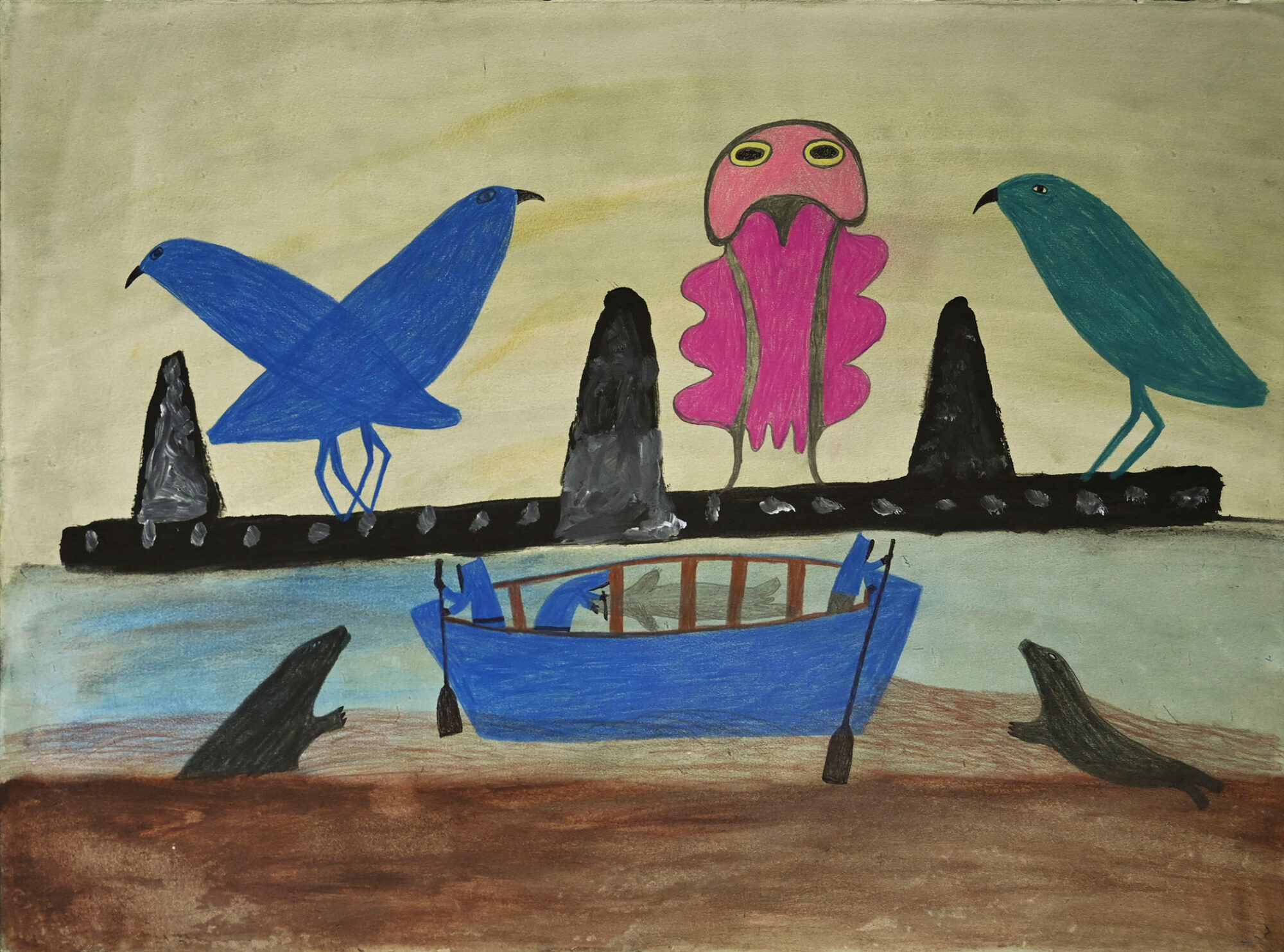

Lucy Qinnuayuak, Untitled, 1979. Acrylic paint, pencil and black marker drawing on paper. LUMAC Collection, Art Gallery of Sudbury | Galerie d’art de Sudbury.
ᓘᓯ ᕿᓐᓄᐊᔪᐊ, ᐊᑎᖃᙱᖅᑐᖅ, 1979. ᐊᒥᐋᕆᔾᔪᑎ ᐊᒥᐊᖅ, ᑎᑎᖅᑐᔭᐅᑎ ᐊᒻᒪᓗ ᕿᕐᓂᖅᑕᖅ ᑎᑦᑕᕆᒃᑎᑦᑎᔪᖅ ᐊᓕᓚᔪᐊᓄᑦ. ᓗᕋᓐᓯᐊᓐ ᓯᓚᑦᑐᖅᓴᕐᕕᐊᓗᒃᒥᑦ ᑕᑯᔭᒐᖃᕐᕕᒃᒥ ᐊᒻᒪᓗ ᓴᓇᐅᒐᓕᕆᕝᕕᒃᒥ ᓄᐊᓯᒪᔭᖏᑦ, ᓴᓇᖕᖑᐊᖅᓯᒪᔪᓂᒃ ᑕᑯᔭᒐᖃᕐᕕᒃ ᓴᑦᐳᓕ.
Kenojuak Ashevak, Untitled, 1981. Pencil crayon and marker drawing on paper. LUMAC Collection, Art Gallery of Sudbury | Galerie d’art de Sudbury.
ᕿᓐᓄᐊᔪᐊ ᐊᓯᕙᒃ, ᐊᑎᖃᙱᖅᑐᖅ, 1981. ᑎᑎᖅᑐᔭᐅᑎᒧᑦ ᐊᒥᐋᖅᑎᕆᔾᔪᑎᒧᑦ ᐊᒻᒪᓗ ᑎᑦᑕᕆᒃᑎᑦᑎᔪᕐᒧᑦ ᑎᑎᖅᑐᒐᖅᓯᒪᔪᖅ ᐊᓕᓚᔪᐊᓄᑦ. ᓗᕋᓐᓯᐊᓐ ᓯᓚᑦᑐᖅᓴᕐᕕᐊᓗᒃᒥᑦ ᑕᑯᔭᒐᖃᕐᕕᒃᒥ ᐊᒻᒪᓗ ᓴᓇᐅᒐᓕᕆᕝᕕᒃᒥ ᓄᐊᓯᒪᔭᖏᑦ, ᓴᓇᖕᖑᐊᖅᓯᒪᔪᓂᒃ ᑕᑯᔭᒐᖃᕐᕕᒃ ᓴᑦᐳᓕ.
Prior to 1966 the only drawing utensil available to artists was graphite, however, with the first orders of coloured pencils and felt tip pens, artists could express themselves as colourists as well as draftsmen.2 With more colourful mediums being accessible to Inuit artists, their artworks began showing a creative and fantastical side that was not as evident in the monochromatic graphite drawings.
1966 ᑐᖔᓂ ᐊᒥᐊᕈᑏᑦ ᐊᑐᐃᓐᓇᐅᔪᑐᐊᖑᓚᐅᖅᑐᑦ ᑎᑎᕐᑐᒐᖅᑎᓄ ᑎᑎᕋᐅᑎᓅᖅᑐᓂᒃ, ᑭᓯᐊᓂ, ᓯᕗᓪᓕᖅᐹᒥ ᑎᑭᓴᐅᓪᓗᑎᒃ ᐊᒥᐊᖃᖅᑐᓂᒃ ᑎᑎᕋᐅᑎᓂᒃ ᐊᒻᒪᓗ ᓄᕗᖃᖅᑐᓂ ᑎᑎᕋᐅᑎᓂᒃ, ᑎᑎᕐᑐᒐᖅᑏᑦ ᑕᑯᑎᑦᑎᔪᓐᓇᖅᓯᓚᐅᖅᑐᑦ ᑎᑎᕐᑐᒐᖅᑎᐅᑦᑎᐊᕐᓂᕐᒥ ᐱᓯᑎᐅᓂᖏᓐᓂ.2 ᐊᒥᐊᖃᖅᑐᓂᒃ ᐊᖅᑯᑎᓂᒃ ᐊᑐᐃᓐᓇᐅᓂᖅᓴᐅᓂᖏᓐᓂ ᐃᓄᖕᓄ ᑎᑎᕐᑐᒐᖅᑎᓄ, ᑎᑎᕐᑐᒐᖅᑕᖏ ᑕᑯᑎᑦᑎᓕᓚᐅᖅᑐᑦ ᐃᓱᒪᑐᓂᖏᓐᓂ ᐊᒻᒪᓗ ᐱᐅᔪᓂᒃ ᓴᓇᒃᑲᐅᓂᖏᓐᓂ ᑕᑯᒃᓴᐅᓚᐅᖏᑦᑐᒥ ᕿᕐᓇᕆᒃᑐᓄᑦ ᑎᑎᕐᑐᒐᖅᑕᐅᔪᓂᒃ.
Kenojuak Ashevak was the first woman to be encouraged to draw by the Houstons after Alma Houston recognized her talent for design in her sewing.3 Kenojuak’s experience with creating designs to adorn bags, clothing, and tapestries influenced her use of repeating and mirrored motifs in her drawing and later her prints.4
ᕿᓐᓄᐊᔪᐊ ᐊᓯᕙᒃ ᓯᕗᓪᓕᖅᐹᖑᓪᓗᓂ ᐊᕐᓇᐅᓪᓗᓂ ᐃᑲᔪᖅᓱᖅᑕᐅᓚᐅᖅᑐᖅ ᕼᐃᐅᔅᑕᓐᒧ ᑎᑎᕐᑐᒐᕐᓂᕐᒥ ᐱᒋᐊᖁᔭᐅᓪᓗᓂ ᐋᓪᒪ ᕼᐃᐅᔅᑕᓐ ᐃᓕᓴᕆᒐᒥᐅᒃ ᐱᓯᑎᐅᓂᖓᓂ ᑕᖅᓯᖅᓱᐃᓂᕐᒥ ᒥᖅᓱᖅᑕᖏᓐᓂ ᑕᑯᒃᓴᐅᔪᓂᒃ.3 ᕿᓐᓄᐊᔪᐊ ᐊᑐᕐᓂᕕᓂᖓ ᑕᖅᓯᖅᓱᐃᓂᕐᒥ ᐴᒃᓴᓂᒃ, ᐊᓐᓄᕌᓂᒃ, ᐊᒻᒪᓗ ᐊᑭᓐᓇᕐᒥᐅᓂᒃ ᐊᒃᑐᐃᓂᖃᓚᐅᖅᑐᖅ ᐅᓄᖅᑑᓕᖅᓯᒪᔪᓂᒃ ᐊᒻᒪᓗ ᐊᔾᔨᖃᖅᑐᓂᒃ ᑕᖅᓴᓂᒃ ᑎᑎᕋᐅᔭᖅᑕᖏᓐᓂ ᐊᒻᒪᓗ ᑭᖑᓂᑦᑎᓐᓂ ᑎᑎᕐᑐᒐᖅᑕᖏᓐᓂᒃ.4
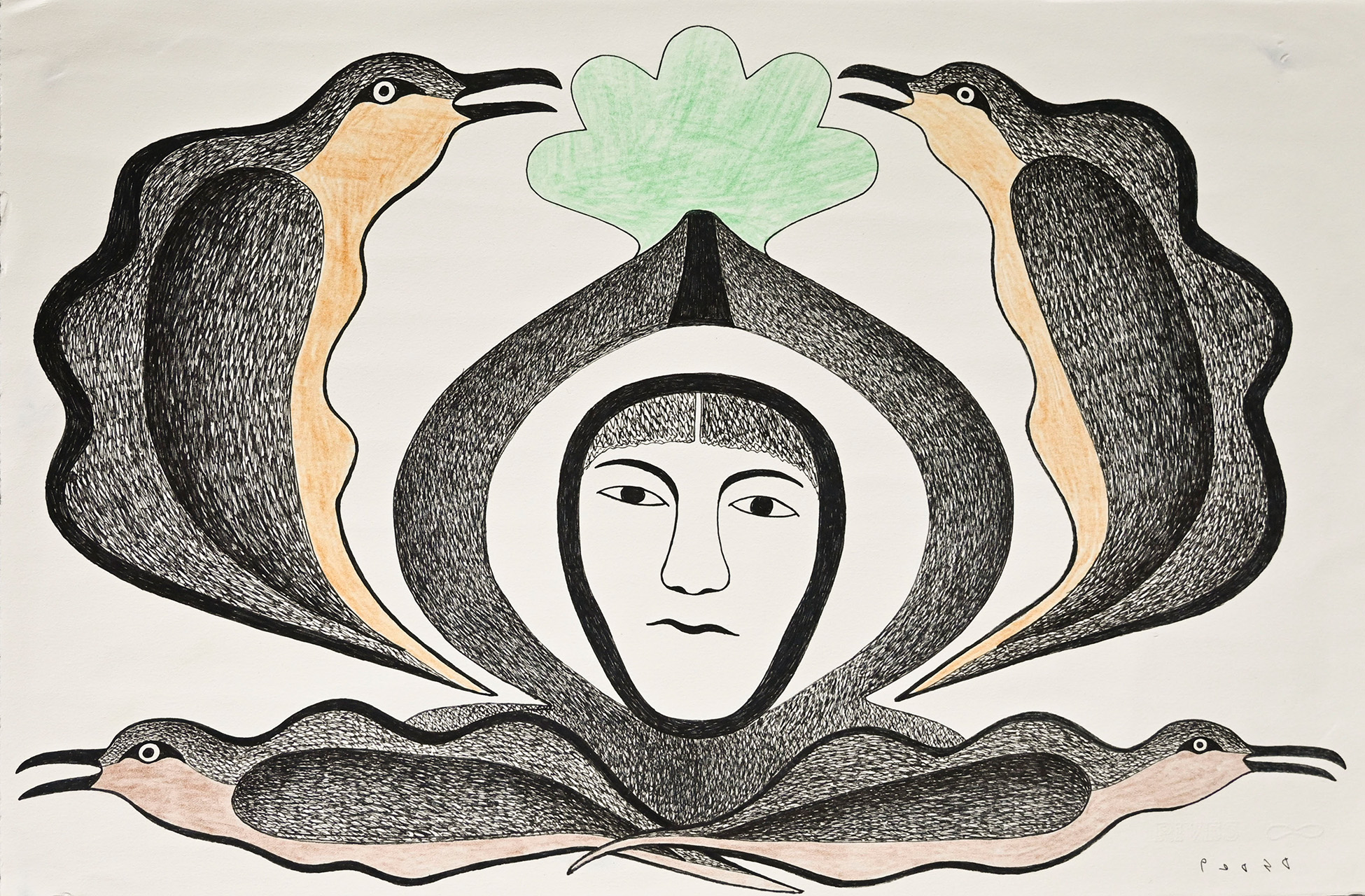
Kenojuak Ashevak, Untitled, undated. Pencil crayon and marker drawing on paper. LUMAC Collection, Art Gallery of Sudbury | Galerie d’art de Sudbury.
ᕿᓐᓄᐊᔪᐊ ᐊᓯᕙᒃ, ᐊᑎᖃᙱᖅᑐᖅ, ᐅᓪᓗᓕᖅᑕᐅᓯᒪᖏᑦᑐᑦ. ᑎᑎᖅᑐᔭᐅᑎᒧᑦ ᐊᒥᐋᖅᑎᕆᔾᔪᑎᒧᑦ ᐊᒻᒪᓗ ᑎᑦᑕᕆᒃᑎᑦᑎᔪᕐᒧᑦ ᑎᑎᖅᑐᒐᖅᓯᒪᔪᖅ ᐊᓕᓚᔪᐊᓄᑦ. ᓗᕋᓐᓯᐊᓐ ᓯᓚᑦᑐᖅᓴᕐᕕᐊᓗᒃᒥᑦ ᑕᑯᔭᒐᖃᕐᕕᒃᒥ ᐊᒻᒪᓗ ᓴᓇᐅᒐᓕᕆᕝᕕᒃᒥ ᓄᐊᓯᒪᔭᖏᑦ, ᓴᓇᖕᖑᐊᖅᓯᒪᔪᓂᒃ ᑕᑯᔭᒐᖃᕐᕕᒃ ᓴᑦᐳᓕ.
When the Houstons began traveling to the camps around Kinngait to ask others to draw, Lucy Qinnuayuak was one of the first to oblige.5 After relocating to Kinngait, Lucy became a prolific drawer and experimented with depicting animals and scenes from everyday life in a mix of media including graphite, coloured pencils, watercolour, and acrylic paints.6 In addition to depicting narrative scenes, Lucy also utilized a mirrored composition of birds and fish in her works like Kenojuak.
ᕼᐃᐅᔅᑕᓐ ᑭᙵᐃᑦ ᓯᓚᑖᓄ ᐊᐅᓪᓛᕐᕕᖕᓄᐊᑲᑕᓕᖅᑎᓪᓗᒍ ᐊᓯᖏᓐᓂᒃ ᑎᑎᕋᐅᔭᖁᔨᓪᓗᓂ, ᓘᓯ ᕿᓐᓄᐊᔪᐊ ᓯᕗᓪᓕᖅᐹᖑᓚᖃᑕᐅᓚᐅᖅᑐᖅ ᑎᑎᕋᐅᔭᓯᒋᐊᖅᖢᓂ.5 ᑭᙵᕐᓄᑦ ᓅᓚᐅᖅᑎᓪᓗᒍ, ᓘᓯ ᑎᑎᕋᐅᔭᖅᑎᐅᓂᕐᒥ ᐱᒃᑲᕈᓚᐅᖅᑐᖅ ᐊᒻᒪᓗ ᖃᐅᔨᓴᖅᐸᒃᖢᓂ ᓂᕐᔪᑎᙳᐊᓂᒃ ᐊᒻᒪᓗ ᖃᐅᑕᒫᑦ ᐃᓅᓯᕆᔭᐅᔪᓂᒃ ᑕᑯᑎᑦᑎᓂᕐᒥ ᑎᑎᕐᑐᒐᕐᓂᕐᒧ ᐊᖅᑯᑕᐅᔪᓂᒃ ᐊᔾᔨᒌᖏᑦᑐᓂᒃ ᐊᑐᖅᖢᓂ ᐃᓚᖃᖅᖢᓂ ᑎᑎᕋᐅᑎᓂᒃ, ᑕᖅᓴᓕᖕᓂ ᑎᑎᕋᐅᑎᓂᒃ, ᐃᒪᕐᒥᒃ ᐊᑐᖅᑐᓂᒃ, ᐊᒻᒪᓗ ᐊᒥᐋᕆᔾᔪᑎ ᐊᒥᐊᕐᓂᒃ.6 ᖄᖓᒍᑦ ᐅᓂᒃᑳᖅᑐᒃ ᑎᑎᕐᑐᒐᕐᓂᒃ, ᓘᓯ ᐊᑐᓚᐅᕐᒥᔪᖅ ᐊᔾᔨᖃᖅᑐᓂᒃ ᐃᓗᓕᓕᖕᓂ ᑎᖕᒥᐊᙳᐊᓂᒃ ᐊᒻᒪᓗ ᐃᖃᓗᙳᐊᓂᒃ ᑎᑎᕐᑐᒐᖅᑕᖏᓐᓂᒃ ᕿᓐᓄᐊᔪᐊᑎᑑᖅᑐᓂᒃ.
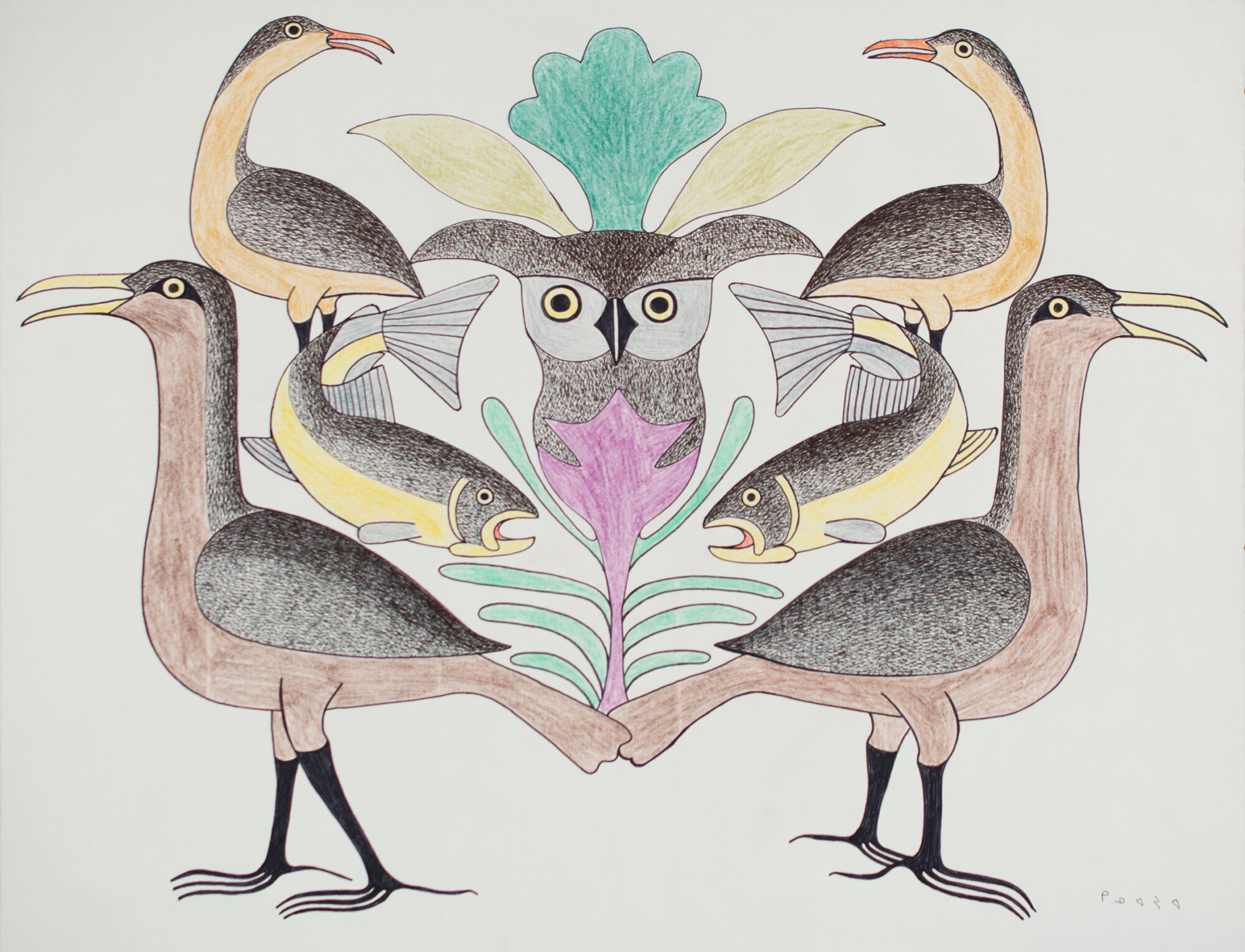
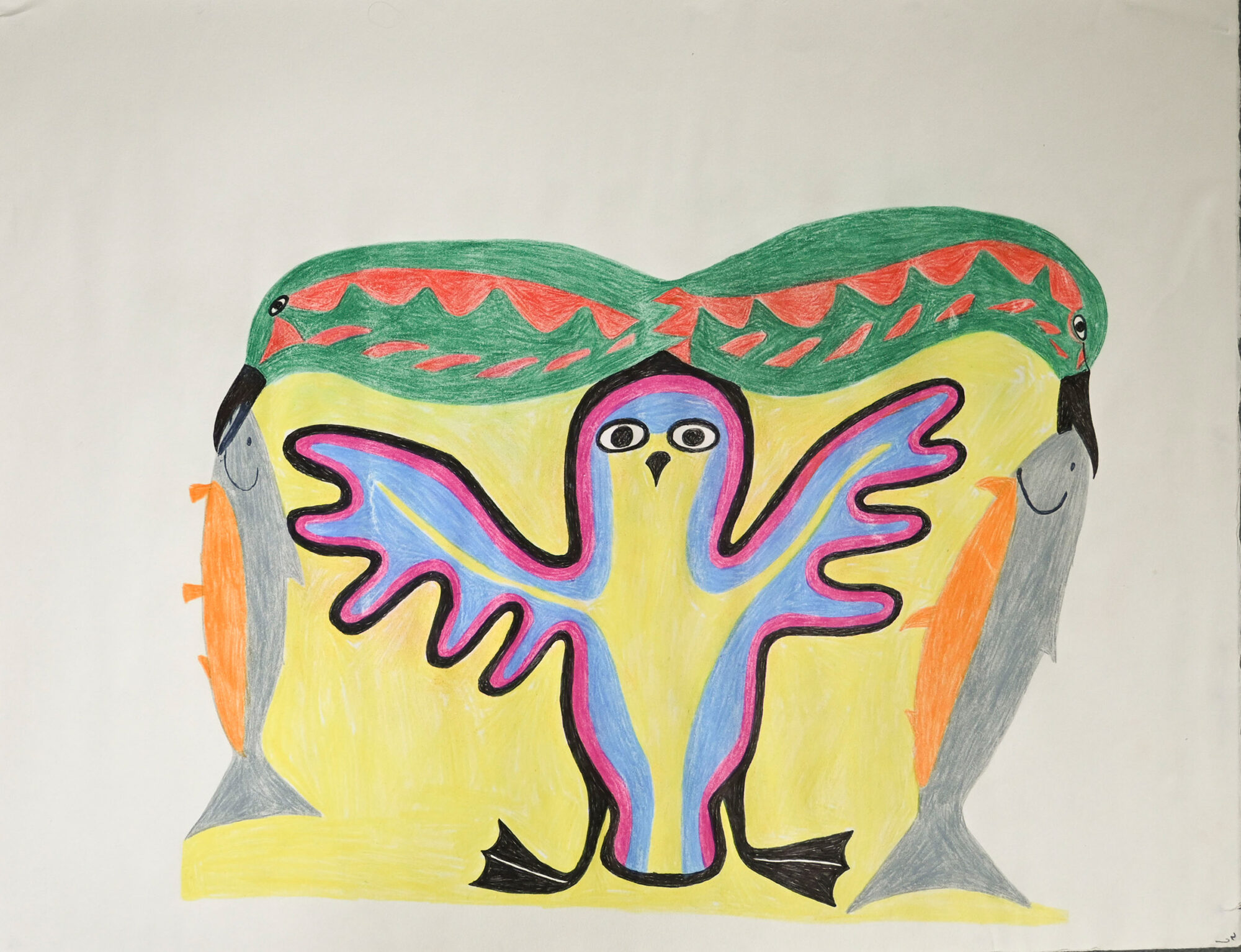
Kenojuak Ashevak, Untitled, 1980-81. Pencil crayon and marker drawing on paper. LUMAC Collection, Art Gallery of Sudbury | Galerie d’art de Sudbury.
ᕿᓐᓄᐊᔪᐊ ᐊᓯᕙᒃ, ᐊᑎᖃᙱᖅᑐᖅ, 1980-81. ᑎᑎᖅᑐᔭᐅᑎᒧᑦ ᐊᒥᐋᖅᑎᕆᔾᔪᑎᒧᑦ ᐊᒻᒪᓗ ᑎᑦᑕᕆᒃᑎᑦᑎᔪᕐᒧᑦ ᑎᑎᖅᑐᒐᖅᓯᒪᔪᖅ ᐊᓕᓚᔪᐊᓄᑦ. ᓗᕋᓐᓯᐊᓐ ᓯᓚᑦᑐᖅᓴᕐᕕᐊᓗᒃᒥᑦ ᑕᑯᔭᒐᖃᕐᕕᒃᒥ ᐊᒻᒪᓗ ᓴᓇᐅᒐᓕᕆᕝᕕᒃᒥ ᓄᐊᓯᒪᔭᖏᑦ, ᓴᓇᖕᖑᐊᖅᓯᒪᔪᓂᒃ ᑕᑯᔭᒐᖃᕐᕕᒃ ᓴᑦᐳᓕ.
Lucy Qinnuayuak, Untitled, 1979-80. Marker and pencil crayon drawing on paper. LUMAC Collection, Art Gallery of Sudbury | Galerie d’art de Sudbury.
ᓘᓯ ᕿᓐᓄᐊᔪᐊ, ᐊᑎᖃᙱᖅᑐᖅ, 1979-80. ᑎᑦᑕᕆᒃᑎᑦᑎᔪᕐᒧᑦ ᐊᒻᒪᓗ ᑎᑎᖅᑐᔭᐅᑎᒧᑦ ᐊᒥᐋᖅᑎᕆᔾᔪᑎᒧᑦ ᑎᑎᖅᑐᒐᖅᓯᒪᔪᖅ ᐊᓕᓚᔪᐊᓄᑦ. ᓗᕋᓐᓯᐊᓐ ᓯᓚᑦᑐᖅᓴᕐᕕᐊᓗᒃᒥᑦ ᑕᑯᔭᒐᖃᕐᕕᒃᒥ ᐊᒻᒪᓗ ᓴᓇᐅᒐᓕᕆᕝᕕᒃᒥ ᓄᐊᓯᒪᔭᖏᑦ, ᓴᓇᖕᖑᐊᖅᓯᒪᔪᓂᒃ ᑕᑯᔭᒐᖃᕐᕕᒃ ᓴᑦᐳᓕ.
Endnotes
1 Jean Blodgett and Susan J. Gustavison, Strange Scenes: Early Cape Dorset Drawings (Kleinburg, ON: McMichael Canadian Art Collection, 1993), 9.
2 M. Routledge and M. E. Jackson, Pudlo: Thirty Years of Drawing (Ottawa, ON: National Gallery of Canada, 1990), 46.
3 Silaqi Ashevak and Leslie Boyd, Kenojuak Ashevak: Life and Legacy (Portland, OR: Pomegranate, 2020), 13.
4 Ashevak and Boyd, Kenojuak Ashevak: Life and Legacy, 15.
5 Odette Leroux, Marion E. Jackson, and Minnie Aodla Freeman, Inuit Women Artists: Voices from Cape Dorset (Vancouver, BC: Douglas & McIntyre, 1994), 72.
6 Leroux, Jackson, and Freeman, Inuit Women Artists: Voices from Cape Dorset, 72.
ᐅᖃᓕᒫᒐᐃᑦ
1. ᔩᓐ ᐸᓛᑦᔭᑦ ᐊᒻᒪᓗ ᓲᓴᓐ J. ᒐᔅᑕᕕᓴᓐ, Strange Scenes: Early Cape Dorset Drawings [ᐊᔾᔨᐅᖏᑦᑐᑦ ᑕᑯᒃᓴᐅᔪᑦ: ᑭᙵᐃᑦ ᑎᑎᕐᑐᒐᕐᓂᖏᑕ ᐱᒋᐊᓕᓵᕐᓂᖏ] (ᑲᓚᐃᓐᐴᒃ, ᐋᓐᑎᐅᕆᔫ: ᒥᒃᒪᐃᑯ ᑲᓇᑕᒥ ᓴᓇᙳᐊᕐᓂᕐᒥ ᓄᐊᑦᑎᓂᕐᒥ, 1993), 9.
2. M. ᕋᐅᑦᓚᑦᓯ ᐊᒻᒪᓗ M. E. ᔮᒃᓴᓐ, Pudlo: Thirty Years of Drawing [ᐸᓪᓗᖅ: ᐊᕐᕌᒍᑦ 30−ᓂᒃ ᑎᑎᕋᐅᔭᕐᓂᖅ] (ᐋᑐᕚ, ᐋᓐᑎᐅᕆᔫ: ᑲᓇᑕᓕᒫᒥ ᑕᑯᔭᒐᖃᕐᕕᒃ ᑲᓇᑕᒥ, 1990), 46.
3. ᓯᓚᕿ ᐊᓯᕙᒃ ᐊᒻᒪᓗ ᓚᔅᓕ ᐳᐃᑦ, Kenojuak Ashevak: Life and Legacy [ᕿᓐᓄᐊᔪᐊ ᐊᓯᕙᒃ: ᐃᓅᓯᖓ ᐊᒻᒪᓗ ᖃᐅᔨᒪᔭᐅᓂᖓ] (ᐳᐊᑦᓚᓐ, ᐅᐊᕋᒑᓐ: ᐹᒪᒍᕌᓇᑦ, 2020), 13.
4. ᐊᓯᕙᒃ ᐊᒻᒪᓗ ᐳᐃᑦ, Kenojuak Ashevak: Life and Legacy [ᕿᓐᓄᐊᔪᐊ ᐊᓯᕙᒃ: ᐃᓅᓯᖓ ᐊᒻᒪᓗ ᖃᐅᔨᒪᔭᐅᓂᖓ], 15.
5. ᐅᑕᑦ ᓚᕉ, ᒥᐅᕆᔭᓐ E. ᔮᒃᓴᓐ, ᐊᒻᒪᓗ ᒥᓂ ᐊᐅᓪᓚ ᕗᕇᒪᓐ, Inuit Women Artists: Voices from Cape Dorset [ᐃᓄᐃᑦ ᐊᕐᓇᐃᑦ ᑎᑎᕋᐅᔭᒐᖅᑏᑦ: ᓂᐲᑦ ᑭᙵᓂᒃ] (ᕚᓐᑰᕗ, ᐳᑎᔅ ᑲᓚᒻᐱᔭ: ᑕᒡᓚᓯ ᐊᒻᒪᓗ ᒫᒃᐃᓐᑕᐅᔪ, 1994), 72.
6. ᓚᕉ, ᔮᒃᓴᓐ, ᐊᒻᒪᓗ ᕗᕇᒪᓐ, Inuit Women Artists: Voices from Cape Dorset [ᐃᓄᐃᑦ ᐊᕐᓇᐃᑦ ᑎᑎᕋᐅᔭᒐᖅᑏᑦ: ᓂᐲᑦ ᑭᙵᓂᒃ], 72.
More Information
Blodgett, Jean, and Susan J. Gustavison. Strange Scenes: Early Cape Dorset Drawings. Kleinburg, ON: McMichael Canadian Art Collection, 1993.
Routledge, M., and M. E. Jackson. Pudlo: Thirty Years of Drawing. Ottawa, ON: National Gallery of Canada, 1990.
Ashevak, Silaqi, and Leslie Boyd. Kenojuak Ashevak: Life and Legacy. Portland, OR: Pomegranate, 2020.
Leroux, Odette, Marion E. Jackson, and Minnie Aodla Freeman. Inuit Women Artists: Voices from Cape Dorset. Vancouver, BC: Douglas & McIntyre, 1994.
ᐸᓛᑦᔭᑦ, ᔩᓐ, ᐊᒻᒪᓗ ᓲᓴᓐ J. ᒐᔅᑕᕕᓴᓐ. Strange Scenes: Early Cape Dorset Drawings [ᐊᔾᔨᐅᖏᑦᑐᑦ ᑕᑯᒃᓴᐅᔪᑦ: ᑭᙵᐃᑦ ᑎᑎᕐᑐᒐᕐᓂᖏᑕ ᐱᒋᐊᓕᓵᕐᓂᖏ]. ᑲᓚᐃᓐᐴᒃ, ᐋᓐᑎᐅᕆᔫ: ᒥᒃᒪᐃᑯ ᑲᓇᑕᒥ ᓴᓇᙳᐊᕐᓂᕐᒥ ᓄᐊᑦᑎᓂᕐᒥ, 1993.
ᕋᐅᑦᓚᑦᓯ, M. ᐊᒻᒪᓗ M. E. ᔮᒃᓴᓐ. Pudlo: Thirty Years of Drawing [ᐸᓪᓗᖅ: ᐊᕐᕌᒍᑦ 30−ᓂᒃ ᑎᑎᕋᐅᔭᕐᓂᖅ]. ᐋᑐᕚ, ᐋᓐᑎᐅᕆᔫ: ᑲᓇᑕᓕᒫᒥ ᑕᑯᔭᒐᖃᕐᕕᒃ ᑲᓇᑕᒥ, 1990.
ᐊᓯᕙᒃ, ᓯᓚᕿ, ᐊᒻᒪᓗ ᓚᔅᓕ ᐳᐃᑦ. Kenojuak Ashevak: Life and Legacy [ᕿᓐᓄᐊᔪᐊ ᐊᓯᕙᒃ: ᐃᓅᓯᖓ ᐊᒻᒪᓗ ᖃᐅᔨᒪᔭᐅᓂᖓ]. ᐳᐊᑦᓚᓐ, ᐅᐊᕋᒑᓐ: ᐹᒪᒍᕌᓇᑦ, 2020.
Text by Ally Zmijowskyj Carlos in consultation with Deanna Nebenionquit
ᑎᑎᕋᖅᑕᐅᔪᖅ ᐋᓕ ᔨᒧᔨᔅᑭᔾ ᑲᐅᓘᔅᓱ ᐅᖃᖃᑎᖃᖅᖢᓂ ᑎᐊᓇ ᓂᐸᓂᐅᑯᐃᑦᒥ

